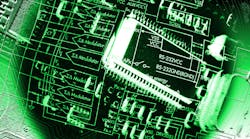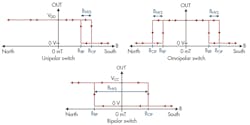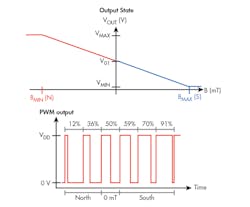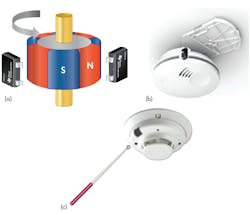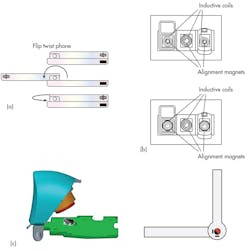Download this article in PDF format.
The main trends in today’s building automation and personal electronics market include miniaturization and portability, along with increasing intelligence and lower costs. Achieving these trends, however, entails both challenges and tradeoffs. One of the most promising technologies for this market is Hall-effect sensing.
The Hall-effect principle is a popular magnetic sensing technology invented by Edwin Hall in 1879. The principle is simply a differential voltage generated in a current-carrying conductor, usually called a Hall element, when applying a perpendicular magnetic field to the conductor. The voltage is a result of a Lorentz force caused by the applied magnetic field, which causes the current electrons to concentrate in one end of the conductor and generate a potential difference between the two ends.
1. The voltage is usually referred to as a Hall voltage (VH).
Figure 1 illustrates the Hall-effect principle and the relationship between the current, voltage, and magnetic field. The generated voltage is usually referred to as a Hall voltage (VH). When a magnetic field isn’t present, the distribution of current electrons is uniform and VH is zero. When a magnetic field is applied, the distribution of current electrons is disturbed and will result in a non-zero VH proportional to the cross product of the current and the applied magnetic field. The current is usually fixed, resulting in a direct relationship between VH and the applied magnetic field.
VH has a very small value (on the order of few microvolts per volt of the supply voltage used to generate the Hall current per millitesla of the applied magnetic field (µV/Vs/mT). To make this voltage value usable, an amplification stage amplifies the differential voltage and rejects any common-mode signal, which is why you need a differential amplifier for this stage.
Figure 2 presents the typical components of a Hall-effect sensor. Different Hall-effect sensors use the output of the differential amplifier in numerous ways to achieve various functions. For more details about Hall-effect sensors and other magnetic sensor technologies, check out Texas Instruments’ (TI) white paper on the subject.
2. Basic Hall-effect sensor building blocks include a power source, the Hall element, and an op amp.
Hall-Effect Sensing Benefits
Hall-effect sensors have proved to be one of the most popular magnetic field sensors for several reasons:
- Low cost
- Low power consumption
- Small footprint
- Reliability
- Simplicity
- Distance sensing
- Versatility (switch, latch, linear and multiple magnetic thresholds)
- True solid state
- Long lifetimes
- Ability to operate with stationary input (zero speed)
- Lack of moving parts
- Logic-compatible input and output
- Broad temperature range (−40 to +150°C)
These features translate into various electrical and magnetic specifications in a particular device data sheet. You can learn more about these specifications and how to interpret them in TI’s “Understanding & Applying Hall Effect Sensor Datasheets” application note. Also, TI has a TechNote on the benefits of low power consumption.
Types of Hall-Effect Sensors
Hall-effect sensors are configurable for different applications. They can generally be classified into two categories: threshold-based and linear.
- Threshold-based Hall-effect sensors can act as a switch that responds to either magnetic poles with a single output (omnipolar), two outputs (dual unipolar), latched output (bipolar), or one pole (unipolar). Typically, if the field is originated from a south pole, the output voltage will be positive. If the field source is a north pole, the output voltage will be negative. TI recently developed a family of low-power Hall-effect digital switches (the DRV5032) and latches (the DRV5012) for digital Hall-effect sensors. Figure 3 shows the transfer function of these sensors.
- Linear Hall-effect sensors are sometimes called ratiometric Hall-effect sensors, because the output is a proportional signal that varies linearly with respect to the applied magnetic field; the supply voltage determines the output range. To avoid using multiple supplies to bias the differential amplifier stage, an applied offset (null voltage) shifts the output to the positive range. Also, because a Hall-effect sensor saturates near the maximum and minimum values, the linear region is usually defined by few hundred millivolts above ground and a few hundred millivolts below the supply voltage.
3. Threshold-based Hall-effect sensors can have different transfer functions.
Linear Hall-effect sensors can respond to either magnetic poles or one pole to increase device sensitivity. Also, the output can be either unmodulated (a linear analog voltage signal) or modulated (a pulse-width-modulation [PWM] signal with a varying duty cycle) to enable use in noisy environments. Figure 4 shows the transfer functions of various linear Hall-effect sensors.
4. Sensor output can follow the linear (ratiometric) Hall-effect sensor transfer function (top) or be used to generate a PWM signal (bottom).
Applications
Hall-effect sensors possess many features that make them attractive for the building automation and personal electronics markets. What follows are several use cases where these sensors enable different functions for various end equipment.
Building automation
5. Building-automation use cases for Hall-effect sensors include rotary encoding (a), tampering/mount detection (b), and self-test (c).
- Rotary encoding: Latched-type (such as TI’s DRV5012) or switched-type unipolar Hall-effect sensors detect the number of rotations of small motors in order to determine the position of electric blinds/shades or smart door locks (Fig. 5a). (See TI’s “Incremental Rotary Encoder Design Considerations” TechNote.)
- Open/close detection: For reliable, highly connected, and portable Internet of Things devices (e.g., battery-powered wireless windows and door security sensors), switched-type Hall-effect sensors are preferable to reed switches because of their low power consumption, smaller footprint, and higher reliability. Plus, they have no moving parts and are less prone to environmental conditions. (See TI’s “Low-Power Door and Window Sensor with Sub-1 GHz and 10-Year Coin Cell Battery Life Reference Design.”)
- Tamper detection: Switch-type Hall-effect sensors can detect the presence or absence of portable security devices from their mounts. Examples include battery-powered doorbells or wireless commercial smoke detectors (Fig. 5b).
- Self-test activation or 1-bit wireless local communication: It can be difficult to physically access certain devices that require regular maintenance to trigger self-testing/diagnostic modes. Placing a switched-type Hall effect sensor inside the device of interest and using a magnetic wand to trigger a self-test or diagnostic mode eases this process (Fig. 5c).
Personal electronics
- Position detection. Switch-type Hall effect sensors can optimize and enable a number of functions in personal electronics devices, including wireless charging alignment for phones and tablets; cover detection for phones and tablets; lid/screen position detection for notebooks; and accessory detection for tablets.
Figure 6 shows a couple of examples of these use cases using threshold-based Hall-effect switches. Linear Hall-effect sensors can precisely detect button positions for gaming and virtual-reality controllers, and screen angle for 360-deg. rotating notebooks.
6. Personal electronics use cases: Hall-effect switches for position detection (a); linear sensor in gaming controller and 360 laptops (b).
Summary
The benefits of Hall-effect sensors, such as low power consumption, cost-effectiveness, and smaller footprints (just to mention a few), position them well within building automation and personal electronics devices. Their versatility enables a variety of use cases, from rotary encoding in smart locks and shades to position detection in phones, tablets, and notebooks.
